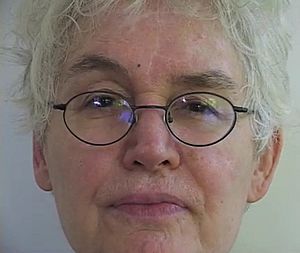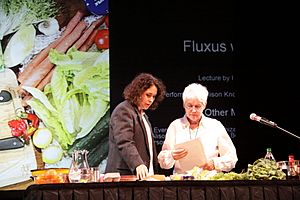Alison Knowles facts for kids
Quick facts for kids
Alison Knowles
|
|
|---|---|

Knowles, c. 2002-5
|
|
| Born | April 29, 1933 Scarsdale, New York, U.S.
|
| Died | October 29, 2025 (aged 92) New York, U.S.
|
| Nationality | American |
| Known for | Performance art, Printmaking |
| Movement | Fluxus |
Alison Knowles (born April 29, 1933, died October 29, 2025) was an American artist. She was known for her unique art installations, performances, sound art, and publications. Knowles was a founding member of Fluxus. This was an international group of artists who wanted to mix different art forms.
Her art often involved performances and allowed for unexpected outcomes. It also encouraged people to touch and interact with the artwork. She earned an honors degree in fine art from Pratt Institute in New York. In May 2015, Pratt awarded her an honorary doctorate degree.
In the 1960s, she was active in New York City's art scene. She worked with famous artists like John Cage and Marcel Duchamp. During this time, she started creating "event scores." These were performances that turned everyday actions into art. Knowles's use of visual, sound, and touch elements made her art special among Fluxus artists.
From July 20, 2022, to February 12, 2023, a special exhibition called by Alison Knowles: A Retrospective (1960–2022) was held. It took place at the University of California, Berkeley Art Museum and Pacific Film Archive.
Contents
Alison Knowles's Early Artistic Journey
Alison Knowles transferred from Middlebury College and graduated from the Pratt Institute in 1956. Her father was a professor there, so she could attend for free. She studied painting and graphic design. A class with painter Richard Lindner greatly influenced her. Knowles realized she was an artist, not just a painter.
John Cage was another important mentor for Knowles. She learned about him through his class at the New School for Social Research in 1958. Many future Fluxus leaders attended this class. Knowles's focus on painting changed after an art show. She decided to move on from painting by destroying her earlier works. This led her to explore new types of art and eventually join Fluxus.
In 1962, on the first Fluxus tour, Knowles began writing "event scores." These quickly became a key part of the Fluxus movement. After participating in early Fluxus Festivals in Europe, Knowles returned to the U.S. She started making art objects, some for George Maciunas, the Fluxus leader.
Knowles's object-based art focused on how the audience could touch and hear the artwork. While other Fluxus artists explored music, Knowles focused on poetry and spoken word. In the 1960s, she began using beans in her art. The bean was a unique choice when other artists used everyday objects.
Creative Book Art by Alison Knowles
George Maciunas invited Knowles to create one of her first "book objects," called Bean Rolls (1963). This was not a regular book. Its "pages" were tiny paper scrolls. Readers could choose and view them in any order. On each scroll, Knowles printed texts from songs, recipes, stories, and ads. The tin also held dried beans. These made a rattling sound when the container was handled. In the 1960s, Knowles expanded Bean Rolls by having multiple people read the scrolls together.
In 1967, Knowles created The House of Dust. This was an early example of digital poetry made with a computer. She worked with composer James Tenney. The poem started as four lists written by Knowles. Choosing a phrase from each list described a house. It would say what it was made of, where it was, how it was lit, and who lived there. Tenney used an early IBM computer to generate the poem. The computer randomly arranged the phrases. Knowles chose one stanza to inspire an interactive sculpture. This sculpture was built on the California Institute of the Arts campus in the early 1970s.
Knowles also made larger book projects, like The Big Book (1967). This was a walk-in structure with eight movable "pages." Each page was four feet wide and eight feet tall. They were connected to a metal spine. Each page had an opening to the next, creating different spaces. The whole piece weighed about a ton. It included a gallery, a library, a grass tunnel, and a window. It was made from found materials like a toilet, stove, and telephone. The book traveled to cities and gradually changed as it moved. The Big Book inspired her other large installations, The Book of Bean and The Boat Book.
The Boat Book was first shown at Art Basel Miami Beach in January 2014. Knowles described it as a "book sculpture." It featured a hoop structure covered with blue silk, like the ocean. It also included a porthole, fishing nets, a fishing pole, and an anchor.
Engaging Event Scores and Performances
"Event scores" are performances first created by George Brecht. They were inspired by John Cage's experimental classes. Many Fluxus artworks are simple performance pieces. Knowles described an event score as "a one or two line recipe for action."
One of her most famous scores is The Identical Lunch (1969). It came from her habit of eating the same lunch every day. This was "a tuna fish sandwich on wheat toast, with lettuce and butter, no mayo and a cup of soup or a glass of buttermilk." Her friend Philip Corner noticed her routine. Knowles decided to invite people to join her for lunch. She documented all the small details and repetitions. This made the everyday meal a thoughtful reflection. Knowles said it was "about having an excuse to get to talk to people, to notice everything that happened, to pay attention."
Touch was a special part of Knowles's art. Her notable event score, Make a Salad, was first performed in 1962 in London. In this performance, Knowles prepared a huge salad. She chopped vegetables to the rhythm of live music. She mixed the ingredients by tossing them in the air. Then, she served the salad to the audience. Make a Salad has been performed in many places worldwide, including the Tate Modern and Art Basel 2016.
Shoes of Your Choice also premiered in 1962. For this piece, Knowles simply asked participants to describe the shoes they were wearing. In 2011, Knowles performed Shoes of Your Choice for President Barack Obama and First Lady Michelle Obama. This was part of "A Celebration of American Poetry" at the White House.
Exploring Sound in Art
Knowles actively explored sound in her art starting in the late 1960s. In 1969, she helped design and edit John Cage's Notations. This was a book of music manuscripts.
Her Bean Garden was first shown at the Annual Avant Garde Festival of New York. It was a large platform covered with beans and amplified. Visitors could walk across it. Each step made the sounds of the beans resonate. Knowles also made sound objects. These included a bean turner (a flax paper pouch with beans) and wrist rubbers (flax paper "gloves" with beans). She also created a bamboo and flax accordion.
Knowles's interest in bean sounds led to four radio programs. These were hosted by the German station Westdeutscher Rundfunk. In 1982, Knowles received the Karl Sczuka Award for best radio work for her event score, Bean Sequences.
Prints and Collaborations
Knowles began making silkscreen paintings in the early 1960s. These were shown at the Judson Gallery. From 1963 to the mid-1970s, printmaking was a way to express her other artistic ideas.
In 1963, she worked with Robert Watts and George Brecht on the Scissors Brothers Warehouse show, also known as BLINK. This print featured three randomly chosen images, one from each artist. These images appeared on various items, from canvases to bathing suits. Knowles also created the Identical Lunch graphic series. This series showed her friends and Fluxus colleagues eating The Identical Lunch in the early 1970s.
In the late 1960s, Knowles worked closely with Marcel Duchamp. She helped recreate his optical artwork, Coeurs Volants. The original was made in 1936. Knowles initially wanted to reproduce the image for a book cover. But after meeting Duchamp, they decided she would create a new silkscreen version. Knowles visited Duchamp to choose colors. Due to a misunderstanding, Duchamp jokingly signed one of the color samples. This is considered by some to be his last "readymade" artwork.
About Alison Knowles's Life
Alison Knowles was born in Scarsdale, New York, on April 29, 1933. She was married to Dick Higgins, another important Fluxus artist. He created the term "intermedia." They had twin daughters, Jessica and Hannah Higgins. Both daughters participated in Fluxus-related events when they were young. Knowles often performed art pieces with her family members.
Knowles lived and worked in her loft in New York City's SoHo district since the 1950s. She passed away in New York on October 29, 2025, at the age of 92.
Awards and Recognition
Alison Knowles received many awards for her important contributions to modern art. These included a Guggenheim Fellowship (1967) and National Endowment for the Arts Grants (1981 and 1985). She also received a collaborative New York State Council on the Arts Grant (1989).
Other honors included a documenta Professorship in Germany (1998) and the College Art Association Lifetime Achievement Award (2003). She also received an Anonymous Was a Woman Grant (2003). In 2015, art historian Claire Bishop selected Knowles for a Francis J. Greenburger Award. This award recognizes under-recognized artists every two years.
See also
 In Spanish: Alison Knowles para niños
In Spanish: Alison Knowles para niños


